| ■ J-PARC News - March 2017 (Issue #143) |
| ● The J-PARC's former Deputy Director, Koichiro Nishikawa was informally selected as a 2016 Bruno Pontecorvo Prize winner. |
|---|
| Professor emeritus Koichiro Nishikawa, J-PARC's former Deputy Director and former Director of the Institute of Particle and Nuclear Studies in High Energy Accelerator Research Organization (KEK), and two other researchers were nominated for the 2016 Bruno Pontecorvo Prize (February 24). This prize is annually awarded to outstanding physicists in the field of particle physics. This year's award was for "outstanding achievement for elucidating the phenomenon of neutrino oscillation and the measurement of the mixing angle θ13 with 3 experiments.” Dr. Nishikawa formerly led the T2K (Tokai to Kamioka) experiments that have had progress elucidating neutrino oscillation with accelerator neutrinos. Such experiments so far have proven that oscillations change from muon neutrinos into electron neutrinos, and that the probability of oscillations is higher than expected. The prize winners, along with Dr. Nishikawa, were representatives of Chinese and Korean physicists who worked on reactor neutrino experiments. |
 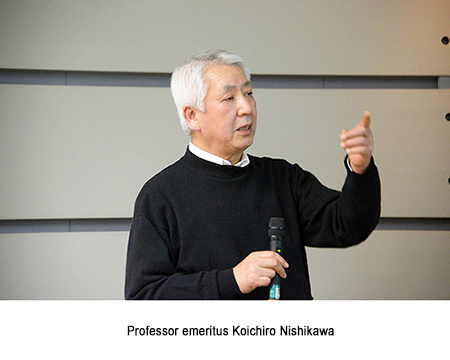
 * Click here to enlarge. * Click here to enlarge. |
| |
| ▲to Page Top |
| |
|
| ● The 22nd Outstanding Paper Award of the Physical Society of Japan for the discovery of new type of nuclei "xi hypernuclei" |
|---|
| Research being conducted at the Hadron Experimental Facility includes an experiment by a group consisting of Kazuma Nakazawa, a Gifu University Professor, and J-PARC researchers for the "E07 experiment". The group developed a new analysis method called "overall scanning" and re-analyzed nuclear plates that were obtained through experiments at KEK in Tsukuba campus from 1997 through to 2000. As a result, the "xi hypernuclei" nucleus that has bounded xi nuclei containing two strange quarks was discovered. The group also found from the results that interactions between xi particles and neutrons, and xi particles and protons, were attractive, which was an indication that neutron stars may contain xi particles. The findings were reported in a paper in 2015, and received the 22nd Outstanding Paper Award of the Physical Society of Japan. |
| |
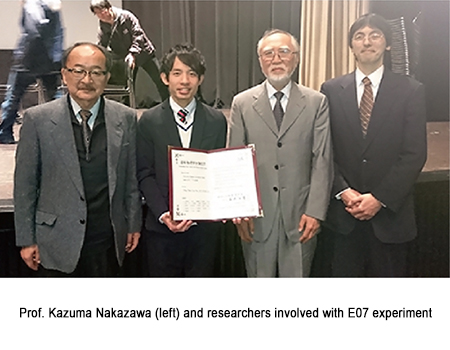
 * Click here to enlarge. * Click here to enlarge. |
| |
| ▲to Page Top |
| |
|
| ● Formation of Novel substance: one metal atom containing as many as 9 hydrogen atoms. (March 14, press conference) |
|---|
| A research group led by Shigeyuki Takagi, Associate Professor of Tohoku University Institute for Materials Research, succeeded in forming novel substances consisting of one metal atom containing as many as nine hydrogen atoms. The group used neutron diffraction measurement with NOVA (High Intensity Total Diffractometer) at the Materials and Life Science Experimental Facility (MLF). In 2015, the research group developed a synthesis method for chromium, one of the elements that has difficulty binding with hydrogen by itself, to bind with 7 hydrogen atoms, more than most metals that commonly bind with hydrogen. The researchers then had high hopes for binding with more hydrogen. They have worked with other elements such as molybdenum, belonging to the same element group as chromium, in the synthesis of complex hydrides. Results of this research were published in the online version of the "Scientific Reports" (a science magazine from UK) on March 14, 2017. |
| |
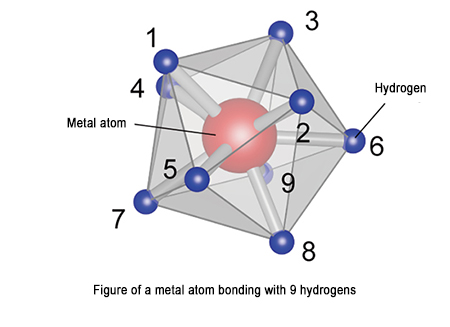
 * Click here to enlarge. * Click here to enlarge. |
| |
| ▲to Page Top |
| |
|
| ● The world's first successful synthesis of perovskite oxide PbCoO3 and discovery of new charge distribution - high hopes for functional oxide development - (March 21, press conference) |
|---|
| Perovskite-type oxide materials have a variety of features, such as ferroelectricity, superconductivity and colossal magnetoresistance. They are actively researched all over the world. The group of Yuki Sakai, research fellow of the Kanagawa Academy of Science and Technology, and Masaki Azuma, professor of Tokyo Institute of Technology, was able to synthesize perovskite oxide PbCoO3 using an ultrahigh-pressure of 15 GPa. The group found that it had formed a new charge distribution with charge orders for both lead and cobalt. This result was confirmed by a structural analysis using the Super High Resolution Powder Diffractometer (SuperHRPD) of MLF and Spring-8, a large synchrotron radiation facility. This research finding was published in the March 15th online edition of the United States chemistry journal "Journal of the American Chemical Society". |
| |
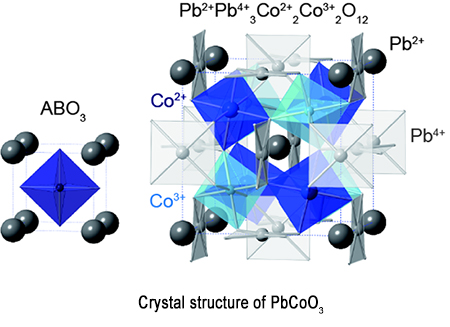
 * Click here to enlarge. * Click here to enlarge. |
| |
| ▲to Page Top |
| |
|
| ● J-PARC International Advisory Committee (IAC2017) was held (February 20-28, J-PARC research building, etc.). |
|---|
| From February 20 through to 28, 4 advisory committee meetings* were held to review the J-PARC facility and its management with an international perspective by inviting domestic and foreign experts. The Neutron Advisory Committee (NAC2016 February 20-21), Muon Science Laboratory Facilities Committee (MAC/MuSAC 2016, February 22-23), Accelerator Technical Advisory Committee (A-TAC2016, February 23-25), and IAC top committee meetings were held, and overall operation of J-PARC was reviewed. |
| In IAC, J-PARC's officials reported J-PARC's facility status and future plans, a chairperson of each committee reported summaries of discussions (in their meetings). Participants actively discussed and exchanged opinions. At the end of the committee meetings, on behalf of the IAC Chairman, Mr.Robert Tribble presented valuable recommendations on J-PARC's management. |
| * Transmutation Experimental Facility Technical Advisory Committee meeting (T-TAC) was held on December 12 through 14, 2016. |
| |
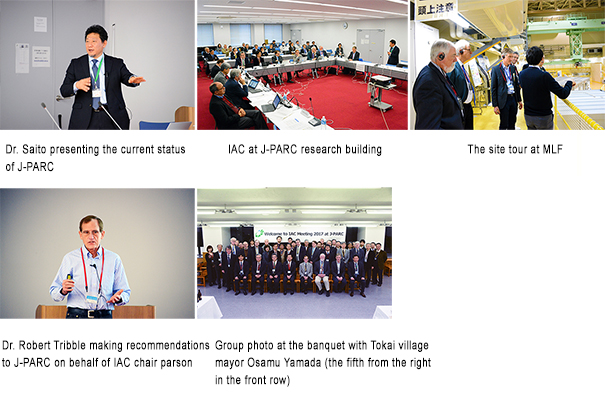
 * Click here to enlarge. * Click here to enlarge. |
| |

 * Click here to enlarge. * Click here to enlarge. |
| |
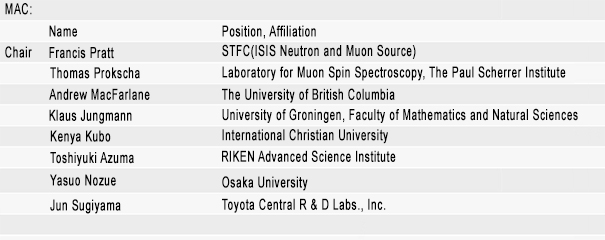
 * Click here to enlarge. * Click here to enlarge. |
| |
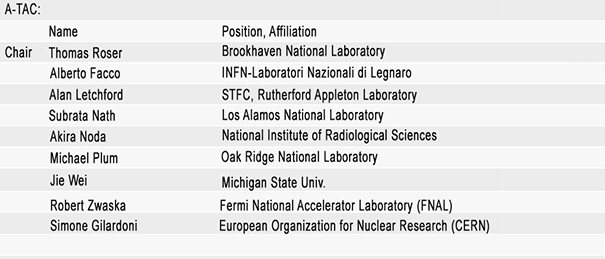
 * Click here to enlarge. * Click here to enlarge. |
| |
| * Neutron Advisory Committee Published in J-PARC News issue #142 (published on February 2017) |
| * Transmutation Experimental Facility Technical Advisory Committee Published in J-PARC News issue #140 (published on December 2016) |
| |

 * Click here to enlarge. * Click here to enlarge. |
| ▲to Page Top |
| |
|
| ● J-PARC Center Kyoto University Branch was established (February 22, J-PARC). |
|---|
| On February 22nd, for collaboration and cooperation of High Energy Accelerator Research Organization (KEK) and Kyoto University, a memorandum of understanding (MoU) signing ceremony was held at the J-PARC research building. This memorandum of understanding will establish a J-PARC branch of Kyoto University at KEK Tokai Building No.1 and allow Kyoto University researchers and students to cooperatively research in J-PARC. Kyoto University already has concluded a basic agreement with KEK to promote coordination and cooperation. The faculties of the Graduate School of Science, the Graduate School of Engineering, the Institute for Chemical Research, and Research Reactor Institute, etc. will jointly conduct the T2K (Tokai to Kamioka) experiment, Hadron experiments, and experiments related to fuel cells at J-PARC, while teaching graduate students. This branch will foster closer research cooperation between J-PARC and Kyoto University. |
| |
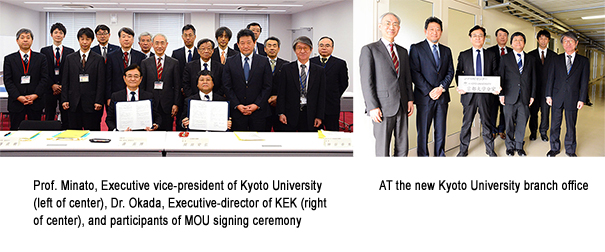
 * Click here to enlarge. * Click here to enlarge. |
| |
| ▲to Page Top |
| |
|
| ● FY 2016 Quantum Beam Science Festa /8th MLF Symposium / 34th PF Symposium was held (March 14-15, Tsukuba International Congress Center). |
|---|
| On March 14 and 15, FY2016 Quantum Beam Science Festa was held with sponsors such as J-PARC Center, KEK Institute of Materials Structure Science, and Comprehensive Research Organization for Science and Society (CROSS). The event was successful with as many as 580 participants. The second day, MLF Symposium was held with a theme, "aiming to maximize the performance and ease of use of facility". It had very active discussions on research findings at the facility as well as the status of the facility and areas of improvement, future planning for MLF. Matthew Tucker from United States Oak Ridge National laboratory was invited for a special MLF session. Participants were interested in his report on the progress of his research on the local structure analysis of crystalline and amorphous materials. ( Photo by: Science Festa Committee ) |
| |
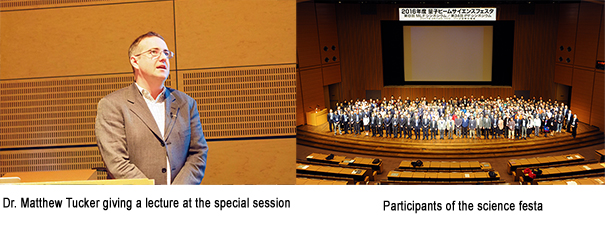
 * Click here to enlarge. * Click here to enlarge. |
| |
| ▲to Page Top |
| |
|
| ● J-PARC Hello Science "What is an accelerator?" (February 27, AEON Tokai store) |
|---|
| Since last December, J-PARC Center has been holding "J-PARC Hello Science" at the food court of AEON Tokai store at JR Tokai station venturing out for friendly exchanges with researchers and locals. On our 3rd event on February 27th, Dr. Michikazu Kinsho from J-PARC Center's Accelerators Division gave a lecture on "What is an accelerator?"※ and about 15 people attended. Dr. Kinsho explained the operating principles of the accelerator using a cathode-ray tube television, used in many households until recently, as an example. He also explained the history of accelerator development, and accelerators at J-PARC as well as around the world. Moreover, he told the audience that in recent years, accelerators are used in some medical devices, and Tokai-village has a research facility to promote the practical application of state-of-the-art cancer treatments from Ibaraki Prefecture, such as BNTC (Boron Neutron Capture Therapy). |
| Next J-PARC Hello Science will be held at Tokai-village Industry and Information Plaza (iVil) on April 28 (Friday). We will start at 6 PM with a talk, "Neutrino Solves the Ultimate Cosmic Mystery", by Dr. Sho Tada from J-PARC Center Neutrino Section. For details, see J-PARC website. And, we look forward to your participation. |
| * Sponsored by: Tokai-village/ Tokai-village board of education |
| |

 * Click here to enlarge. * Click here to enlarge. |
| |
| ▲to Page Top |
| |
|
| ● J-PARC Hello Science in Muramatsu Elementary School (March 1, Tokai-village) |
|---|
| March 1st, J-PARC Center held "J-PARC Hello Science" at Tokai-village Muramatsu Elementary School's science club. The theme was "the secret of light". For the experiment of the three primary colors of light, participating students were in wonder to see mixing three colors of glowing liquid (blue, red and green) turn white. Following the experiment, the students enjoyed making a kaleidoscope of light using a spectral sheet. This was an experiment of dividing the light into the colors of the rainbow. From a pinhole in a shape, a beautiful rainbow showed up. Upon leaving school, those participants were proudly showing off their kaleidoscopes to friends. |
| |
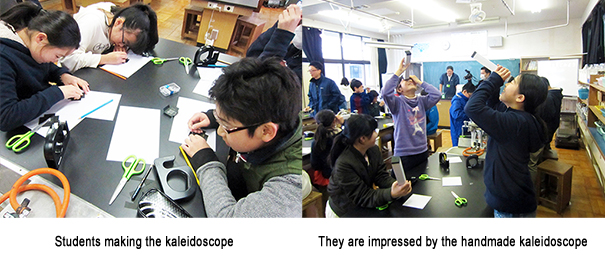 |
| |
| ▲to Page Top |
| |
|
©2017 J-PARC Center. All rights reserved.
|
|